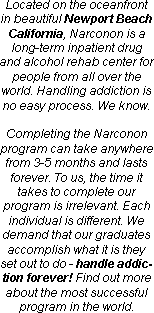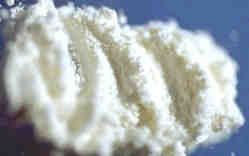
|
Navigate |
| Home |
| Kirstie Alley |
| Our 30th Anniversary |
| Never Turning Back |
| Narconon Endorsements |
| |
|
|
| |
|
|
| |
|
Facts About Drugs |
| FAQ About Ambien |
| FAQ About Ativan |
| FAQ About Cocaine |
| FAQ About Codeine |
| FAQ About Crack |
| FAQ About Darvocet |
| FAQ About Dexedrine |
| FAQ About Demerol |
| FAQ About Dilaudid |
| FAQ About Ecstasy |
| FAQ About GHB |
| FAQ About Heroin |
| FAQ About Hydrocodone |
| FAQ About Ketamine |
| FAQ About Lortab |
| FAQ About LSD |
| FAQ About Marijuana |
| FAQ About Morphine |
| FAQ About Meth |
| FAQ About Methadone |
| FAQ About Opiates |
| FAQ About Opium |
| FAQ About Oxycontin |
| FAQ About Percocet |
| FAQ About Percodan |
| FAQ About Ritalin |
| FAQ About Rohypnol |
| FAQ About Ultram |
| FAQ About Valium |
| FAQ About Vicodin |
| FAQ About Xanax |
  |
|
Resources |

|


 Print this article |  Send this article to a friend |  Add to Favorites |
FAQ
About Meth

Q) What is Methamphetamine?
A) Methamphetamine is a stimulant drug chemically related to amphetamine but with stronger effects on the central nervous system. Street names for the drug include "speed," "meth," "crystal," and "crank." Methamphetamine is used in pill form, or in powdered form by snorting or injecting. Crystallized methamphetamine known as "ice," "crystal," or "glass," is a smokable and more powerful form of the drug.
Q) How widespread is Methamphetamine addiction?
A) Methamphetamine use has spread to all areas of the United States and continues to be on an upswing. Estimates from the Drug Abuse Warning Network (DAWN) indicate that methamphetamine-related emergency room episodes increased 346 percent from 1991 to 1995.
Q) What are the effects of Methamphetamine addiction?
A) A methamphetamine-induced "high" artificially boosts self-confidence, many users are overcome by a so-called "superman syndrome." In this state, methamphetamine abusers ignore their physical limitations and try to do things which they are normally incapable of performing. Meth is highly addictive because people often continue using the drug to avoid an inevitable crash that comes when the drugs' positive effects begin to wear off. Even first time users experience many of meth's negative effects.
Methamphetamine's negative effects include, but are not limited to, the following:
|
Severe amphetamine induced depression and/or psychosis
Methamphetamine stimulates
the central nervous system, causing chemical reactions in the brain and tricking
the body into believing it has unlimited energy supplies and draining energy reserves
needed in other parts of the body. This is why meth addicts tend to stay awake
for long periods of time and then eventually crash, feeling tired, depressed and
much worse than they did before they took the drug. Chemical imbalances in the
brain and sleep deprivation commonly associated with continued meth use result
in hallucinations, extreme paranoia and often bizarre, violent behavior.
Meth causes extensive damage to the body, and can cause death or permanent physical damage.
Physiological
effects of methamphetamine use include:
Abnormally high blood pressure; rapid
and irregular heart rate and rhythm; seizures; damage to blood vessels in the
brain (stroke); accumulation of excess fluid in lungs, brain tissue and skull;
continuous/excessive dilation of the pupils; impaired regulation of heat loss;
Hyperpyrexia (body temperatures higher than 104°); internal bleeding; damage
to other organs caused by disruption of blood flow; and breakdown of muscle tissue,
leading to kidney failure.
Similar to other drug substances, smoking and inhaling meth damages the lungs and nasal passages, and intravenous use can lead to spread of the AIDS virus.
The drug appeals to the abuser because it increases the body's metabolism and produces euphoria, alertness, and gives the abuser a sense of increased energy. But high doses or chronic use of meth, also known as "speed," "crank," and "ice," increases nervousness, irritability, and paranoia.
Q) How is Methamphetamine used?
A) Methamphetamine addiction has three stages:: low intensity, binge, and high intensity. The binge and high-intensity abusers smoke or inject meth to achieve a faster and stronger high; the patterns of abuse differ in the frequency in which the drug is abused and the stages within their cycles.
The binge abuse cycle is made up of these stages: rush, high, binge, tweaking, crash, normal, and withdrawal.
Rush (5-30 minutes) -The abuser's heartbeat races and metabolism, blood pressure, and pulse soar. Feelings of pleasure.
High (4-16 hours) -The methamphetamine addict often feels aggressively smarter and becomes argumentative.
Binge (3-15 days) -The methamphetamine addict maintains the high for as long as possible and becomes hyperactive, both mentally and physically.
Tweaking -The most dangerous stage of the cycle. See section below.
Crash (1-3 days) -The addict does not pose a threat to anyone. He becomes very lethargic and sleeps.
Normal (2-14 days) -The abuser returns to a state that is slightly deteriorated from the normal state before the abuse.
Withdrawal (30-90 days) -No immediate symptoms are evident but the abuser first becomes depressed and then lethargic. The craving for methamphetamine hits and he may becomes suicidal. Taking methamphetamine at any time during withdrawal can stop the unpleasant feelings so, consequently, a high percentage of addicts in treatment return to abuse.
High-intensity abusers, often called "speed freaks," focus on preventing the crash. But each successive rush becomes less euphoric and it takes more meth to achieve it. The pattern does not usually include a state of normalcy or withdrawal. High-intensity abusers experience extreme weight loss, very pale facial skin, sweating, body odor, discolored teeth and scars or open sores on their bodies. The scars are the results of the abusers' hallucinations of bugs on his skin, often referred to as "crank bugs," and attempts to scratch the bugs off.
Tweaking
The most dangerous stage of meth abuse for abusers, medical personnel, and law
enforcement officers is called "tweaking." A tweaker is a methamphetamine
addict who probably has not slept in 3-15 days and is irritable and paranoid.
Tweakers often behave or react violently and if a tweaker is using alcohol or
another depressant, his negative feelings and associated dangers intensify. The
tweaker craves more meth, but no dosage will help re-create the euphoric high,
which causes frustration, and leads to unpredictability and potential for violence.
A tweaker can appear normal: eyes can be clear, speech concise, and movements brisk. But a closer look will reveal the person's eyes are moving ten times faster than normal, the voice has a slight quiver, and movements are quick and jerky. These physical signs are more difficult to identify if the tweaker is using a depressant.
Tweakers are often involved in domestic disputes and motor vehicle accidents. They may also be present at "raves" or parties and they may participate in spur-of-the-moment crimes, such as purse snatchings or assaults, to support their habit.
Q) Where does Methamphetamine come from?
A) Methamphetamines can be produced virtually anywhere. Motel rooms, trailer parks, and suburban homes can all be turned into clandestine "meth" labs capable of producing substantial quantities of the drug. The technical know-how needed to produce methamphetamines can easily be found on the internet. These peculiarities make the production of methamphetamine unique, and especially difficult to control. Recent analyses have indicated that methamphetamine from these labs can be as high as 97-99 percent pure.
About the only thing that stands in the way of widespread production and distribution of methamphetamine is the limited availability of the chemicals required to make it. Ephedrine and hydriotic acid, two components of methamphetamine, are tightly controlled in the United States. Yet the recent surge in methamphetamine use suggests that drug traffickers are finding ways around this impediment.
Although the precursor chemicals may be effectively regulated in the United States, in Mexico they are not. Highly organized Mexican drug trafficking syndicates have taken advantage of their country's lenient regulatory practices to dominate the United States' methamphetamine trade. Utilizing the same trafficking routes through which up to 70 percent of the cocaine arriving in the United States now passes, the Mexican trafficking organizations have been able to deliver the chemicals needed to produce methamphetamine to associates living in the United States. These associates then "cook-up" and distribute the final product. In addition to this practice of illicit chemical diversion, these criminal groups also smuggle methamphetamine produced in Mexico to the United States.
Q) When did Methamphetamine abuse start?
A) Amphetamines - Amphetamine, dextroamphetamine and methamphetamine are collectively referred to as amphetamines. Their chemical properties and actions are so similar that even experienced users have difficulty knowing which drug they have taken.
Amphetamine was first marketed in the 1930s under the name Benzedrine in an over-the-counter inhaler to treat nasal congestion. By 1937, amphetamine was available by prescription in tablet form and was used in the treatment of the sleeping disorder narcolepsy and something called minimal brain dysfunction (MBD), which today is called attention deficit hyperactivity disorder (ADHD). During World War II, amphetamine was widely used to keep the soldiers going. During this period, both dextroamphetamine (Dexedrine) and methamphetamine (Methedrine) became easily available.
As use of amphetamines spread, so did the tendency to become addicted. Amphetamines became a cure-all for helping truckers to complete their long routes without falling asleep, for weight control, for helping athletes to perform better and train longer, and for treating mild depression. Intravenous amphetamine abuse spread among a subculture known as "speed freaks." As time went on, it became evident that the dangers of abuse of these drugs outweighed most of their therapeutic uses.
In 1965, greater attempts to control amphetamines were instituted with amendments to the federal food and drug laws to curb the black market in amphetamines. Many pharmaceutical amphetamine products were removed from the market and doctors prescribed those that remained with reluctance. In order to meet the ever increasing black market demand for amphetamines, illegal laboratory production mushroomed, especially methamphetamine laboratories on the West Coast. Today, most amphetamines distributed to the black market are produced in clandestine laboratories.
If you have a problem with meth addiction call Narconon Southern California drug rehab center, we can help 1800 US NO DRUGS

comment corner
 |
| drug rehabilitation saving taxpayers |
California taxpayers are saving more money than expected due to ... |
 |
| Study: Marijuana Causes Lung Damage |
New research finds that smoking three or four marijuana cigarettes ... |
 |
| Thanks to Online Pharmacies, Addiction Can Be Just a Click Away |
WASHINGTON -- Kelly Knable, a 34-year-old mother of three from ... |
 |
| Balancing pain and drug addiction |
Over the past two decades, two conflicting medical ideas have ... |
 |
| Clean break |
... |
 |
| State officials create prescription drug abuse task force |
TALLAHASSEE, Fla. -- State officials on Friday announced the creation ... |
 |
| Florida system often fails to catch Medicaid abuse at source |
FORT LAUDERDALE, Fla. - (KRT) - The victim's skin was ... |
 |
| Marijuana's rising threat: For more kids, use turns into addiction |
John Brown experimented with marijuana at age 10, and it ... |
 |
| Student gets state prison term for selling marijuana |
EASTON -- David Messina had his whole life ahead of ... |
 |
| Man charged in cocaine case forfeits $585,000 |
An Iowa truck driver arrested by Kentucky Vehicle Enforcement officers ... |
 |
| Cocaine Curtails Body's Ability to Cool Off |
In addition to triggering life-threatening cardiovascular episodes, cocaine can be ... |
 |
| Science for Cops |
I admit it: I'm a Law & Order fan. ... |
 |
| New Gene Therapy Could Help Quell Alcoholic Cravings |
One prevailing view of addiction holds that alcohol and other ... |
 |
| One Dose of Cocaine Primes the Brain for Addiction |
It isn't a myth: one dose of cocaine is all ... |
 |
| Marijuana Firmly Linked to Infertility |
Scientists from the University of Buffalo have smoked out what ... |
 |
| Moderate Alcohol Consumption Clouds Brain's Ability to Detect Mistakes |
It's common knowledge that a brain on booze doesn't function ... |
|
Narconon Pictures |
|
   |
|